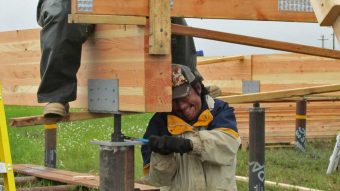When should I worry about snow accumulation on the roof?
With heavy snow in the Fairbanks area recently, people are starting to worry about their roofs. On January 5, 2022, the snow load at a monitoring station at Creamers Field was 23.4 pounds per square foot (psf). According to local building codes, a roof should be designed to carry a minimum 50 psf. However, there are a lot of different factors that affect the performance of a roof, and your roof is only as good as the quality of the workmanship that went into it. This article describes where those numbers come from, and other ways to evaluate the safety of your roof.
Snow loads vary widely across Alaska, from 300 pounds per square foot in a maritime climate like Whittier to as little as 25 psf in northern Alaska. One major factor is the moisture content of snow. In the Interior, think of how a handful of snow feels in mid-December versus one in mid-May, when it’s finally moist enough for a snowball or possibly even a snowman.
The moisture content of snow ranges from about 1 percent to about 33 percent (water weighs about 62 pcf). Compressed snow – even snow that simply accumulates over time—will weigh more than freshly fallen snow. Fallen snow can also pick up humidity from the air and increase in weight, and drifting can also add to its weight.
You determine weight by using a measurement called Snow Water Equivalent (converting inches of snow into inches of water by taking a cylindrical core sample of snow and melting it). You can find the daily SWE for different locations in the state, including Fairbanks, at the USDA Natural Resources Conservation Services website.
On January 5, 2022, for example, the snow depth at Creamer’s Field in Fairbanks was 21 inches and the SWE was 4.5 inches.
To calculate pounds per square foot, you multiply the SWE by a conversion factor of 5.2
That gives you a snow load of roughly 23.4 pounds per square foot (psf). Note: this is only an estimate for the region. Snow loads in areas only a few miles apart can vary significantly.
Current building code in the city of Fairbanks calls for roofs to withstand a minimum of 50 psf, but homes built before 1991 were required to carry 40 psf and older homes even less. Thus, snow loads in the 30-35 pounds per square foot range can cause some roofs to collapse. Mobile homes can be built to carry just 20 psf.
Also, keep in mind there is no building code outside of the city limits. Roof load carrying capacity can vary depending upon type of roof, roof slope, melting and re-freezing of snow and ice, among other factors.
Sloped roofs that periodically shed snow present benefits and risks. If snow slides safely onto open ground, there’s no problem. But if snow hits a deck on the way down, its force is multiplied many times more than its resting weight and can shear otherwise stable structures right off, and severely injure or even kill people in its path..
Structures should be designed with overhangs or other features to offer sliding snow a safe path to the ground. The ability of chimneys or utility poles to withstand sliding snow should also be considered.
In addition, decks, sheds, greenhouses, campers, and other structures built without permits or an inspection may not be able to handle much if any load depending on the quality of the workmanship. An underbuilt roof structure may also be at risk for collapse from imbalanced loading. For example, if the snow slides off one side of the roof yet remains on the other, the roof must be able to withstand the forces working against the structure during a change in weight distribution.
How do you know if you have a problem? Well, if you’re not privy to the design specifications of your home, the safest route is to hire a structural engineer to inspect your roof. An inspection can also reveal potential weak spots or places where your roof structure, deck, or framing might fail. Consider how additions or modifications might affect your home’s ability to support snow. Wood tends to be very flexible and can withstand a lot of force over time before it snaps. But eventually, if it is not built to the task, it can fail.
If you are worried about your roof, it is best to call a structural engineer for an inspection, or hire a professional contractor to clear your roof. If you decide to do it yourself, use caution: the addition of your own weight on an already stressed roof can make matters worse. If the roof is sagging or creaking, get down immediately.





